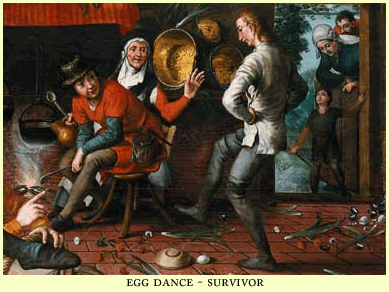footnotes, appendices and apparatus to the anatomy
grouped loosely by subject
12. on the Renaissance

Not at all like hospitals used to be. Back in the days when they could not do any actual medicine, hospitals were great and often beautiful statements of civic virtue. We might consider the Chelsea Hospital designed by Wren, or the Greenwich hospital where Wren, Hawksmoor and Vanbrugh all pitched in. Jewels of charity on the dung heap of society.
And then there is the Ospedale degli Innocenti in Florence. It is not a hospital in our sense, is more of a hospice, but a work of civic virtue, nevertheless.  It was an orphanage, and it was paid for by the silk guild – portraits of leading members appear in the altarpiece Adoration of the Magi by Domenico Ghirlandaio.
It was an orphanage, and it was paid for by the silk guild – portraits of leading members appear in the altarpiece Adoration of the Magi by Domenico Ghirlandaio.
Built by Brunelleschi between 1419 and 1426, it was one of the great defining events of quattrocento architecture, in the way it integrated classical motifs and strict proportion into a free-and-easy gothic hinterland. It heralded, in art and architecture, a general straightening of lines; an exclusion, by implication ironic for a hospital, of the untidy and disorderly.
The Ospedale does not really exclude.  It is, like any architecture, part of its place – in the case of the Innocenti, it stands in Piazza SS. Annunciata, speaks to the buildings standing alongside and opposite, to the streets around; it is a hub of Christian charity in a more charitable (because less benign) age, a point where orphaned impoverished children and rich silk merchants shook hands (sort of), Florentines and Christians all. There is no injustice, the building would have us believe. Only asymmetry. Hence structure. Hence order.
It is, like any architecture, part of its place – in the case of the Innocenti, it stands in Piazza SS. Annunciata, speaks to the buildings standing alongside and opposite, to the streets around; it is a hub of Christian charity in a more charitable (because less benign) age, a point where orphaned impoverished children and rich silk merchants shook hands (sort of), Florentines and Christians all. There is no injustice, the building would have us believe. Only asymmetry. Hence structure. Hence order.
A more charitable age, when charitable institutions, like works of art or regiments, redounded to the honour of their founders, to the scale of their engagement with the world; an age where civic responsibility demanded that a hospital be a work of art.
Kingston Hospital, like all NHS hospitals, is a fretting, fingernail-biting, feverish neurotic mess. Even if they do know how to practice medicine, how to patch you up and send you back.
back
In time finished drawings would be exchanged...
There is a difference between the drawing habits of, say, Leonardo on the one hand and Michelangelo on the other, whatever the similarities. Leonardo is more fully rooted in the quattrocento, when disegno had a firm material basis. By the middle of the cinquecento, disegno had come to be regarded in some circles as tapping the world of pure forms – a neo-Platonic extension of the intellectual nature of drawing whereby the intellective act preceded the physical one. In the quattrocento this was still not so; you thought with the pen, for a reason.
So, to take some examples, we might note the workshop practice of Verrocchio, remembering that Verrocchio’s workshop employed Perugino, Ghirlandaio and Leonardo among others, which employed a sort of shorthand notation of volumes as an aide to the rapid consideration of composition.
Or we could look at the interaction of text and drawing on a given sheet, whether of Leonardo or Verrocchio – I have known contemporary artists use as many words as lines, almost, on a sketch with a concrete purpose – an aide memoire of colours, for instance.
This impurity of purpose still pertained in the cinquecento, but in the quattrocento we are a long way from the presentation drawings of Michelangelo, say, and perhaps nearer to the medieval pattern books in spirit.

Somewhere in the quattrocento there is located a centre of gravity of an art of appropriate scale and proportion; the art of the quattrocento, in sum, was designed for the men who had to pay for it, merchants or friars; by the cinquecento it was designed for the tyrants – pope and princes – who were able to demand it. So the cinquecento, the so called High Renaissance, is the renaissance of Michelangelo and his grotesque massiveness; it is the renaissance of Saint Peter’s and its obscenities. The quattrocento is the renaissance of Masaccio and the Pazzi Chapel, a time when even the construction of the great dome of the Florence Duomo was a feat of ingenious brilliance and aesthetic grace, not Egyptian power.
back
...showed us the picture of the dendronautilus...
What attracted me to the dendronautilus, I realised later, was that it resembled something Leonardo might have designed. If I looked back, I thought, through his notebooks of hotchpotch contraptions, flying machines, submersibles, I might find hidden there, overlooked, a design for arboreal exploration.
What did Leonardo know of the Americas? I have only scraps of data:
- Dürer, who may or may not have known Leonardo, on examining some products of the New World in Antwerp in 1500 spoke of the “subtle skill of people in strange lands”.
- The discovery of a godless world peopled by red devils had something smoky and apocalyptic about it for European Christians.
- There is an episode of Star Trek: Voyager where the holographic realisation of Leonardo is transported by a series of improbable accidents to what he supposes to be America in the early cinquecento, but is in reality a planet of the 24th century, where he revels in the technophilic spirit of the age.
So what did Leonardo know of the Americas? I haven’t a clue, but had Leonardo had some notion of rainforests, perhaps he would have derived therefrom the dendronautilus.
back
They achieved this not by purification, exactly, but by exclusion. Many of them – that of Federico di Montefeltro in Urbino, for example - eschewed even the finest examples of the so-called incunabula, the printed works of the quattrocento. Only hand-copied texts would do for him. Typeset was vulgar, copious, gross, like a peasant’s dinner.
Federico built a library which was a collection of books, certainly, but whether it was also a place of contemplation is unclear to me. I know that he had a studiolo built after the descriptions of Pliny, and it is likely that he did his mulling here, or very possibly on horseback, crushing his friends and enemies alike.
back
Pacioli seems to have been familiar with the manuscript of Benedetto Cotrugli (or Benedict Kotruljević - 1416-1469) a merchant of Dubrovnik, entitled della mercatura e del mercante perfetto, (1458?) in which are set out many of the principles of double-entry bookkeeping; it is also clear that the practice had been known in various forms for two centuries before that; moreover certain characteristic elements (such as, for instance, the use of the “opening balance account”, which is first described by Alvise Casanova in his spechio lucidissimo of 1558) are not codified or developed until the sixteenth century.
back
To be clear, for create I do not intend summon from nothing.
The beginnings of surplus capital can be traced from such diverse phenomena as the division of labour or the codification of property rights. Accountancy practice does not bring the capital into being but summon it from latency, give it shape, present it for manipulation. Nevertheless, its availability to merchants or bankers (tellingly much the same thing in quattrocento Florence) is heavily dependent on standardised forms of recording and presenting its movement, its characteristics; it can then be manipulated, transferred.
That the instruments for doing all of this existed in the middle ages is clear; but what those instruments were holding was not capital as we understand it.
back
...well known, at any rate to Pacioli...
Pacioli and Piero were both from Borgo San Sepolcro. The trattato d’abaco was in fact written not for use in a school – there was none in Borgo san Sepolcro – but at the behest of a friend. See J.V. Field, Piero della Francesca: A Mathematician's Art (Yale, 2005) p. 16 and thereabouts.
Field notes that the sudden proliferation of abacus schools towards the end of the thirteenth century coincided with the take off of international banking operations. He finds this ‘suggestive’.
On the subject of Pacioli's use of Piero's trattato d'abaco in his own summa de arithmetica, geometria, proportioni e proportionalità (Venice, 1494) Field says that 'it is more reasonable to regard the borrowing as part of the practical tradition...rather than discussing the matter as a possible case of plagiarism, which is an essentially anachronistic notion." p. 6.
The same could presumably be said of his knowledge of Cotrugli's della mercatura e del mercante perfetto and other manuscript sources, although it goes without saying I haven't bothered to check.
back
Transversals is perhaps not the word; however, when I try to reconstruct the memory of that summer and the Greek myth project, I see the object - the map - laid out on the dining room table (now, incidentally, my desk). As I visualise it, therefore, projecting into the pictorial space of my memory, the fraternal horizontals lie across it like a 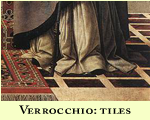 tiled floor in a Verrocchio altarpiece. So I call them transversals.
tiled floor in a Verrocchio altarpiece. So I call them transversals.
Generation, needless to say, would occur down the orthogonals.
back
That a painting is not given the full Alberti does not preclude an organisation in depth. Field notes, for example, of the Baptism of Christ that "there is plenty of natural optics in the picture". The quattrocento would have understood that it was done in perspective, in other words, in the broader sense. The same is doubtless true of anything by Uccello.
back
By Francis Yates, for example, who was certainly no art historian. I think it might be reasonable to say that Botticelli was working within a context of iconographical or symbolical representation where it was not a great leap from Saints with their attributes to pagan gods doing funny stuff in a garden; and while Botticelli was an intense young man who would later chuck examples of his work (so the story goes) on to Savonarola’s bonfires of the vanities, it does not necessarily follow that what he was doing here was making a magical object.
back
...otherwise assuredly present in his work...
...here, for example.
Not that this isn't a strange object in its own right. Note the (beautiful) frame with its diddy ecce homo, for instance. And why doesn't the concrete parterre outside the window conform to the general perspective scheme? And what has happened to the moulding around the window/door/opening?
back
I don’t know about this. I’m looking at reproductions and I can’t tell or remember any more what it is like to stand in front of the real thing. And perhaps I’ve been staring at it too long, but it seem to me a not wholly improbable reading to suggest that the figures float free of the highly idealised pictorial space, so that if the picture plane is taken to be the decorative orangery, then the figures are at best not located in it, but lightly tacked to it; so that, as with an icon, as we move towards the object we enter its space.
back
A bonded servant made 7 ducats per year. The richest merchants in Florence (the Medici, the Strozzi, the Rucellai) would do well to generate annual revenue (not profit) of 20,000 ducats. The alum mines at Tolfa generated around 50,000 ducats in 1480-81 for Pope Sixtus IV, whose annualised income has been estimated at around 290,000 ducats. In the reign of Clement VII, Michelangelo suggested in a letter that his services to the Pope should be valued at a rate of 15 ducats per month; this was taken to be a ludicrously low estimate, and the figure of 50 per month plus expenses was mentioned.
I think a ducat might more or less equal to a florin. Who knows?
back
Federico was injured by a sword blow in a joust at some point after 1450, and lost his right eye and the bridge of his nose. That side of his face was monstrously scarred, by all accounts – he was typically portrayed thereafter in left-profile, although this is also a convention of medallion-portraits in the quattrocento (and there is one painting of him – in triumph – by Piero della Francesca, in which he appears in right-profile).
For all their modern drives and classical sensibility, there remained in the princes and merchant aristocracy of the Renaissance a weakness for medieval chivalric trappings. Martial games had their classical lineage, into which the joust or tournament fitted. In the giostra at Santa Croce of 1469, won, not surprisingly, by the young Lorenzo the Magnificent, the youth of the ottimati paraded to the piazza Santa Croce with their retinues done up in their finest medievals; Lorenzo’s banner, possibly painted by Andrea del Verrocchio (who was responsible for the apparato of the entourage and Lorenzo himself), involved a complicated representation of a female figure standing next to a laurel with all its branches withered bar one, which she was busy weaving into crowns; this was accompanied by the Old French motto le tems revient.
Descriptions of the event are thick with brocades, damsels and fleurs de lys; but Lorenzo’s horse was adorned with a ‘classical’ breastplate, and I am moved to wonder if the time renewed was any particular time, or a mis-remembered jumble of all time, like some post-apocalyptic Mad Max version of history.
Gifts of ceremonial armour were commonplace in the quattrocento: following his triumphant campaign against Volterra, Federico da Montefeltro received an enamelled and gilded silver helmet designed and produced by Antonio del Pollaiuolo, bearing the emblem of a griffin (arms of Volterra) being subdued by Hercules (iconographically associated with Florence). The helmet is now lost, but was much discussed in the literary accounts of Urbino.
No doubt the gnarly Duke (per poco non dimezzato) felt a throb of sympathetic pain as he took possession of the ludicrous object.
Perhaps Minotaur is a touch strong, but I don’t think you would want to stumble in on Federico in his studiolo and catch him in a sulk.
back
...wedding chests or forzieri...
Forzieri are sometimes inaccurately called cassoni. The term cassone did not appear until the cinquecento, and even then did not denote the bridal chest. Forziere denotes a strong box, locked with a key. Draw your own conclusions.
In the sala degli angeli in Urbino, just over your left shoulder as you stand in front of the Ideal City, is this object:
On the assumption that it is a forziere rather than a cassone, it pleases me to think that someone else conceived of marriage as a reconfiguration of space.
back
I say this in the knowledge that Alciati himself regarded his epigrams as directly Saturnalian. In 1522 he wrote to Francesco Calvo, a printer  who was to arrange for the copying of the manuscript (rather than an actual printed edition) ‘During this Saturnalia I have composed a little book of epigrams, to which I have given the title Emblemata’.
who was to arrange for the copying of the manuscript (rather than an actual printed edition) ‘During this Saturnalia I have composed a little book of epigrams, to which I have given the title Emblemata’.
My guess, however, is that Alciati’s understanding of Saturnalia was about as genuinely menacing to the established order as To the Manor Born was to the Thatcherite State in the 1980s. That is partly the point of Saturnalia, but for it to work there have to be real forces at play.
back
...overmastered the challenge of bodies.
At what cost? It is perhaps worth remarking that it is the bodies that now counterbalance the architectural mass – the two figure groups in the Ghirlandaio  seem to edge out to the extremity of their allotted space, as though to stop the whole from capsizing; the figure with his back to us (the painter’s brother Davide) seems to be straining like a yachtsman.
seem to edge out to the extremity of their allotted space, as though to stop the whole from capsizing; the figure with his back to us (the painter’s brother Davide) seems to be straining like a yachtsman.
Berenson, with the insight of a social outsider and snob, noted that the Tournabuoni, who commissioned and peopled the fresco cycle (with something like 27 individual portraits) were themselves social climbers, vulgar new money. The group of figures to the viewer’s left are Tournabuoni, the group to the right are Ghirlandaio himself and his associates (brothers and partner). What are we to conclude? Perhaps nothing. But Joachim in the centre there, in the grip of the visual rhetoric of expulsion (Adam and Eve) as though it were 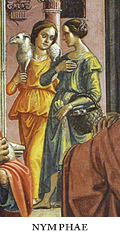 some system of common law, is now distractedly watched by the jovial company, the rival bands of bravi, the social and professional insiders; it is as though this space could comprehend any horror you care to name: those classical nymphae mildly conversing at the back of the composition as they approach the temple might at any moment dismember that lamb and turn in a moment of Dionysian orgy on Joachim (depressive river god) – and just over their heads, in fact, the innocents are being massacred in a thunder of gore - but the bravi would continue to pick their teeth, look their best. Perhaps Giotto, with his irrational space, his claustrophobic rickety temple, is nearer to the spirit of the odd, singular crisis of the moment.
some system of common law, is now distractedly watched by the jovial company, the rival bands of bravi, the social and professional insiders; it is as though this space could comprehend any horror you care to name: those classical nymphae mildly conversing at the back of the composition as they approach the temple might at any moment dismember that lamb and turn in a moment of Dionysian orgy on Joachim (depressive river god) – and just over their heads, in fact, the innocents are being massacred in a thunder of gore - but the bravi would continue to pick their teeth, look their best. Perhaps Giotto, with his irrational space, his claustrophobic rickety temple, is nearer to the spirit of the odd, singular crisis of the moment.
back
...family man, or faction man, or guild man.
Not woman, obviously.
Was a woman in Florence even a moral agent? It is a commonplace that woman were invisible in the public spheres of Florentine life, and while there is some dissent I think it is fair to say that a society in which 11.5% of its females were in nunneries (according to the 1551 catasto; in 1427-8 it was a more modest 2.25%), and the rest of whom are almost invisible in Florentine public life, did not credit the sex with much ethical independence.
We do not distinguish between sexes in the Ideal City, except to note that there are no female citizens, and that is not only a pity but increasingly a matter of some concern – and not only for fear of what a latterday Rosenthal, Elaine. G 1988 might one day write of us.
back
Burkhardt took his history, knowingly or not, from the Commentaries of Pius II. Pius disliked Sigismondo. Here follows his account (in which he speaks of himself in the third person, like Viv Richards) of how he had him burnt in effigy:
Meantime Pius called a consistory and ordered the Cardinal of St. Peter in Vincoli to report what he had learned about Sigismondo Malatesta. The Cardinal said that an examination of the evidence in the case made it clear that Sigismondo was a heretic who denied the resurrection of the dead, asserted that the souls of men were mortal, and had no hope of a future kingdom. Murders, outrage, adultery, incest, sacrilege, perjury, treachery, and almost countless crimes of the most degrading and frightful nature had been proved against him. There was no doubt that he deserved the severest punishment.
The cardinals were asked their opinions and voted unanimously for his condemnation. In a public trial the accused was found guilty of treason against the Pope, of presuming to make impious assertions in regard to the Christian religion, of living a life foul with every crime and infamy. He was deprived of the vicariate and all his dignities and honours and was subjected to those punishments which the laws of men have decreed for heretics and traitors.
Meantime in front of the steps of St. Peters’ there was built a great pyre of dry wood, on top of which was placed an effigy of Sigismondo imitating the wicked and accursed man’s features and dressed so exactly that it seemed a real person rather than an image. But that no one should make any mistake about it, an inscription issued from the figure’s mouth, which read, “Sigismondo Malatesta, son of Pandolfo, king of traitors, hated of God and man, condemned to the flames by vote of the holy senate.” This writing was read by many. Then, while the populace stood by, fire was applied to the pyre and the image, which at once blazed up. Such was the mark branded on the impious house of Malatesta by Pius.”
Commentries of Pius II, trans. Gragg, Smith College Studies in History , 35 (1951), pp. 504-5
Burkhardt, in fairness to him, also notes the following observation of Pius's:
It is hard for us nowadays to believe that a monster like this prince felt learning and the friendship of cultivated people to be a necessity of life; and yet the man who excommunicated him, made war upon him, and burnt him in effigy, Pope Pius II, says: “Sigismund knew history and had a great store of philosophy; he seemed born to all that he undertook.”
The Civilisation of the Renaissance in Italy (1860) I. 235
back
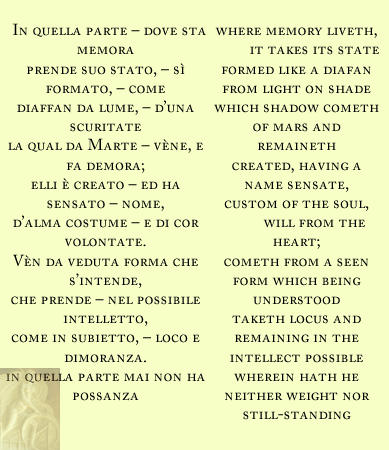
back
...whereas in the quattrocento...
This is a generalisation. The quattrocento knew perfectly well how to move individuals around in space. Francesco Colonna’s Hypnerotomachia Poliphili, for instance, binds the experience of a garden to the hermetic logic of a narrative arc, an unveiling of mysteries as the narrator moves towards the centre, a sort of bucolic and empty-headed Dante in search of his Beatrice.
Less fancifully, the High Renaissance or Mannerist Rhetorical garden can be said not only to find antecedents in the quattrocento, but to locate its origin at the court of Ferrara in the 1470s, where Borso d’Este and his successor Ercole used the remnant earth of a new rampart to construct an artificial mount, which was planted with a boschetto and studded with fountains and pavilions and statues; in the adjoining formal gardens there were grottoes. Ercole also, somewhat later, planted a small lozenge-shaped island in the Po in the same wild manner; this garden was approached through a complex of buildings where, in the forecourt, stood a fountain representing a tree; its trunk was of brass, and jets of water formed the branches.
It was Ercole d’Este’s grandson, Cardinal Ippolito d’Este, who was responsible for the Villa d’Este at Tivoli, and also for converting the vineyards of his cardinalatial residence (Palazzo Quirinale) into a boschetto, notable in its day for its number of statue groups and grottoes. The d’Este connection, in other words, seems to have been a conduit through which the extravagant Ferrarese (quattrocento) manner was imported into Rome.
It amuses me to note that Ippolito’s uncle, also Ippolito d’Este, also a prelate (archbishop of Estergom, Milan, Ferrara) died in 1519 of an indigestion of lobster. I wonder if he thought to remove the exoskeleton.
back
In summarising the various interpretive schemes, Lynette M. F. Bosch notes that ‘No interpretation has yet provided a single source for the garden's images.’ She is modest enough to make no such attempt herself.
Suggestions have focussed on literary allusion and memento mori, whereby the boschetto becomes either a humanist play of wit (not unusual) or a funerary park erected in memory of his wife.
It has also been suggested (by Lynette, in fact, but only on behalf of three of the garden objects) that the organising principle is autobiographical (referencing, for example, his incarceration after the battle of Hesdin and the fidelity of his wife in that period (case pendente) and his jealous rage following the elopement of his mistress, Laura, in July 1574, ( giant dismembering shepherd boy).
According to this last hypothesis, the garden is a region of imprese or emblems. This is a murky but plausible thought; the old Duke decking his wood like a Bluebeard's hall of the memory and imagination. Two of Orsini’s literary circle in Bomarzo in these years were Giovanni Ruscelli and Ludovico Domenichi editors of two of the most influential emblems books of the sixteenth century (Le imprese illustri con ispositioni et discorsi del S. leronimo Ruscelli, Venice, 1556 and L'imprese d'arme et d'amore dialogo di M. Ludovico Domenichi, Venice 1562).
Regardless of the specifics, the garden seems to want to be read like a book of emblems: in or out of sequence, in a progress either logical or surprising. For the initiate (Orsini, perhaps his visitors) this approximates to a meditative excursion that must have at least felt like a gnosis; for the non-initiate (Orsini's peasants, us) it is like being left alone for an hour in the house of a stranger.
Orsini was a dilettante antiquarian and had family lands up near Sovano, where in the sixteeth century there were extant examples of Etruscan gabled aedicule tombs. One of the objects in the Sacro Bosco has been read as mock ruin of just such an edifice. Northern Lazio was an Etruscan heartland, and suggestions have been made not just of an antiquarian’s Etruscomania, but of a cultural persistence influencing Orsini and his countrymen from Bomarzo, some monstrous Etruscan effluent permeating the land.
back
The second half of the sixteenth century saw the development of hydraulically operated automata in grottos. Salomon de Caus (1576-1626) for instance, noted hydraulicist, who made idiosyncratic contributions to many of the great gardens of the late 16th and early 17th including the Hortus Palatinus and Somerset House, supplied working representations of, among other subjects, “a Galatea drawn straight across the waters by two dolphins and coming back by herself, while a Cyclops plays the shepherd’s flute.”
Such automata, in themselves a species of theatricality, were often also used as backdrop or prop in theatrical presentations in the gardens.
I am moved to remark that theatre is itself an intermediate monstrous form in the life of the mind, and am troubled by the suspicion that I am using Kelley’s garden, both through my hydraulic project and through my psychic disposition, as a theatrical space for the representation of my own mysteries – allegorical dogs, stock Irish and Italian gangsters, Boccaccian farce.
back
The instrument is a Renaissance lira da braccio rather than a classical lyre. It is not  easy to see here, as it appears to disappear up Priapus's skirts, but Bellini painted an angel playing one on the San Zaccaria alterpiece of 1505, which you can see, left.
easy to see here, as it appears to disappear up Priapus's skirts, but Bellini painted an angel playing one on the San Zaccaria alterpiece of 1505, which you can see, left.
The lira da braccio, with its two drone strings (bourdons), belongs to a now-defunct evolutionary branch of stringed instruments, pushed from their niche, I suppose, by the more muscular, more Neanderthal viols, which in their turn were superseded by the hyper-intelligent violin family.
Attending a concert of Renaissance music is much like visiting the Natural History Museum.
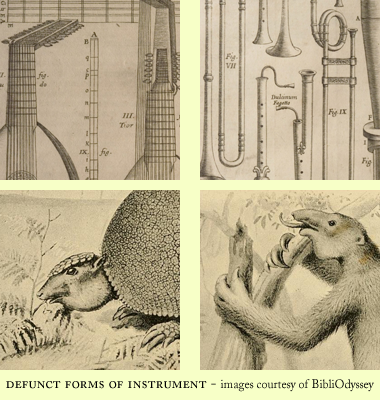
Your eye wanders over the stage, spotting the extinct grotesques, the parping, flapping, cumbrous curiosities, and you try in vain to name them: Sackbut? Theorbo? Oboe da caccia? Basset Pommer? Tromba marina? Hurdy-Gurdy? - as you might, in a museum of bones, try to pick out the auroch or the glyptodon.
back
...pricks of lusts and snorting asses.
I would be pleased to think it, but ultimately the picture is too strange to postulate an inner convivium. There is something disconcerting about those watchful or indifferent gods, after all, that excites, in the wrong mood, horror. What Priapus does, it seems, is his affair. The only being who will be woken by the braying is Lotis. Mercury and Proserpine in particular are dream-like watchers of the rape of their sister (perhaps a naiad is too inconsequential a being for them to care). And both Proserpine and Mercury, and indeed all of the gods, are acquainted with rape first hand, one way or another.
Or perhaps, in fact, it is that very dream-like state of indifference or inaction - they show not even amusement at what is passing, although we are assured by Ovid that the braying of the ass was accompanied by gales of laughter - which suggests the assembly of inner spirits in the first place.
back
...creeping around the edges of the African continent...
The Portuguese were on a steep learning curve with a new world of their own, and were increasingly dismayed to find the Guinean coast turning South again after Cameroon. When they finally arrived in the Indies (in 1497) Vasco de Gama, like Columbus, attempted to trade with the indigenous population, offering as barter goods beads and coloured glass. Worth a try, perhaps, but the Indian merchants, representatives of a mature and thriving economy, had all the beads and coloured glass they needed, and were no doubt politely mystified.

If Columbus really had reached the East and not the Caribbean he would have been in a similar position, attempting impossible trades in gold-roofed pavilions, and at some level he must have known this. Perhaps he, and Vasco de Gama, were relying on the protocols of gift giving rather than the inherent value of the gifts given. Or perhaps these early voyages were intended as nothing so much as proof of concept - make the technical link, and the rest will follow.
Or perhaps they were indeed as foolish as they appear.
back
...in the monochrome of woodcut...
This is not strictly true. The first three woodcuts here, for example, were printed by Flemish engraver Theodor de Bry (1528-1598) in his various published accounts of the Americas, but they were based on watercolour illustrations by John White, Jaques le Moyne de Morgues and others (de Bry himself never crossed the Atlantic), and in subsequent editions they were often tinted:
However, I think it is fair to say that we are a long way from Titian.
back
...the impossible weightlessness of Ideal Geometry itself.
It followed that the Ideal Fortification could only be built on a flat site, just as in designing the Ideal City you start necessarily with a blank sheet of paper, somewhere flat and characterless (neither too hot nor too cold, too damp nor too dry, says Alberti). There is no wresting with an existing topography or the complex pressures of context.
In the 1460s and 70s, the Sienese architect, Francesco di Giorgio Martini (1439-1502), architect to Federigo da Montefeltro in Urbino and successor there to Luciano Laurana (c. 1420-1479), worked on a remote fortification, the castle of San Leo, perched on a sheer cliff above the drear and empty land of the Marche.  The fort had a reputation for impregnability, in part for its imposing stone works, but mostly for its unscalable perch. There was little an architect or engineer need do, except pile up the stones.
The fort had a reputation for impregnability, in part for its imposing stone works, but mostly for its unscalable perch. There was little an architect or engineer need do, except pile up the stones.
By 1494 Martini was in Naples, and present at the siege which would render San Leo and all other fortification in Italy suddenly irrelevant. When, in the 1490s he published his revised trattati d'architettura civile e militare (Codex Magliabechiano) he stated in book V, in which he dealt with fortification, that “the strength of the fortress depends upon the quality of its plan rather than the thickness of its walls”, an obvious and necessary but nonetheless revolutionary departure from all logic of fortification propounded hitherto. “The ancients”, Martini explains, “did not know our artillery”.
Martini, in proposing that henceforth the power of mind, not the accidents of geology or the piling up of stones, would determine the strength of fortifications, was setting the tenor of the coming century. It would be generally held (although not without contention) that the most perfect – functionally, the best – fortification was that which was built in the open, where the logic of geometry could be most completely brought to bear.
Hence Palmanova, you might say, lodged like an uplifted fossil in the centre of an empty plain, defending horizons of earth and sky from invisible armies, the rumour of the Turk, and, ultimately, nothing at all.
back
...think of as her grotto.
In the decade following the advent of Charles VIII in Italy, Isabella d’Este (1474-1539) busied herself hollowing out the redundant medieval castle in Mantova into which she had moved on her marriage with Francesco II Gonzaga (in 1490), and creating in its rocky secluded interior a fair approximation of a Renaissance palazzo.
Isabella’s complex of rooms comprised a bed chamber, the studiolo proper, a private oratory, a large reception room (the camera degli armi) a library cabinet and a camerino da bagno. She was also close to the camera picta of Mantegna. On the floor below the main suite of rooms was a grotto, a small room with a gilded stucco ceiling into which, it may be supposed, Isabella would from time to time, Erda-like, descend.
A great prince, like a great Magus, discharges her power into talismans, synecdotes, emblems, and extends her empire over the realms of speaking objects; who knows but that there in that deep cave Isabella would mull, arrange and rearrange the most precious of her polysemous artefacts, seeking the correct arcane alignment, as though a syntactic energy of understanding might thus be released, fit matter for proper contemplation.
back
... distinct locales, Flemish and Dutch.
The patterns of survival and persistence (both of individual works and of tradition) are not merely the outcome of a simple geographical dispersal of iconoclasm.
At the time of the great Beendenstorm or Iconoclasm of the 1560s and 1580s Protestantism was more firmly rooted in the (more latterly Catholic) South, and Catholicism in the (now firmly Protestant) North. And the Beendenstorm started in the South and touched Ghent and Antwerp earlier and more fully than the Northern towns.
The economic centre of gravity shifted significantly from the Southern Netherlands (Ghent, Bruges, Antwerp) to the Northern Netherlands (Amsterdam) in the course of two centuries. The Northern Netherlands could successfully defend its independence against Spain by breaking the dykes and flooding the polders, the Southern Netherlands could not.
Flemish art was already diffused across (mostly Hapsburg) Europe by the second half of the sixteenth century, and can still be viewed to better advantage in Madrid and Vienna than in Belgium. The same cannot be said for the less prestigious Dutch art of the same period. Thus the output of Pieter Aertsen (1508/9-1575) was more vulnerable than those of Pieter Bruegel, to take one example, and his greatest works - altarpieces, public art - were mostly destroyed. For some reason, the Egg Dance was excepted.
back
...the encirclement of the Devilish Turk.
Belgrade had fallen in 1521, the year after the accession of Suleiman the Magnificent, and in 1522 the Knights Hospitaller were driven out of Rhodes. The Hungarian forces were defeated at the battle of Mohács in August 1526, and by 1529 would be at the gates of (Hapsburg) Vienna.
The geography in 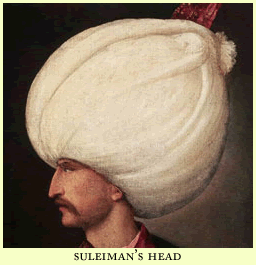 Suleiman’s head will have been very different. He had his own troubling borders – for instance that with the Safavid Persians with whom he fought a series of long and inconclusive wars. Moreover there was a long history of Ottoman alliance with Christian Princes – such as the French, between 1542 and 1546.
Suleiman’s head will have been very different. He had his own troubling borders – for instance that with the Safavid Persians with whom he fought a series of long and inconclusive wars. Moreover there was a long history of Ottoman alliance with Christian Princes – such as the French, between 1542 and 1546.
But the trope of the devilish encroaching Turk has a substantial pedigree.
Milton, to take an anachronistic example, refers to Satan as the Great Sultan, and describes his return from Eden by freely mapping the geography of the East on to that of Hell:
As when the Tartar from his Russian foe
By Astracan over the snowy plains
Retires, or Bactrian sophy from the horns
Of Turkish crescent, leaves all waste beyond
The realms of Aladule, in his retreat
To Tauris or Casbeen.
Bk. X, 431-436
And a little later we read of the devils (the ‘great consulting peers’) as ‘raised from their dark divan’ (456-457)
back
Bruegel was at the centre of the humanist circle in Antwerp, friends with the printer Christophe Plantin (1520 - 1589) and the geographer Abraham Ortelius (1527 - 1598); and while the picture is clearly derived from demotic or folk forms channelled through Bosch, its literary sources are Classical (Margaret Sullivan notes in particular Seneca’s On Anger, Horace’s third satire, and the description of Avaritia from the Psychomachia of Prudentius).
The painting has much in common with an earlier engraving by the same artist from his sequence of the seven deadly sins, Ira.
Each of Bruegel’s depictions of the seven deadly sins follows the same compositional pattern of an allegorical figure surrounded by exemplification in detail. Since, Sullivan argues, there was no clear allegorical type for Madness, Bruegel developed his own along the following lines:
Madness is akin to anger. Seneca (selections from whose works were published in Antwerp by Plantin in 1555) regarded extreme anger as a revolt against sanity, and according to Erasmus anger and madness coincide most nearly in the waging of war between Christian princes. Anger can be induced by gluttony (especially alcohol), and avarice. Each detail in the picture can now be related to the operations of gluttony, avarice or anger insofar as they are the offshoot of (artificially induced) Madness or (natural) Folly.
It may also be the case that the two central figures are allegories of the Protestant or heretic revolt on the one hand (Madness) and the Catholic hierarchy on the other (Folly), both at large in a pre-revolt Antwerp, where the iconoclastic Storm of 1566 was only four years away, (by which time Bruegel would be gone, working in Brussels), and the start of the Eighty Years War only two years beyond that.
back
...a veduta of that same square.
The view is from the North. Piazza del Popolo can be regarded as the gateway to Rome, the first bit of the old city the visitor on the Grand Tour would likely see (if we except the Milvian Bridge).
I am, I realise, going to make too much of this, but the doorway that separated Isabella d’Este’s studiolo and grotta in the Palazzo Ducale in Mantova, designed at some point prior to 1505 by Gian Cristoforo Romano, was a repository of emblematic meaning, carrying images of three of the muses (Euterpe, Clio and Thalia) and Minerva, and six of associated animals of various sorts (an owl for Minerva, a peacock for Clio, and so on).
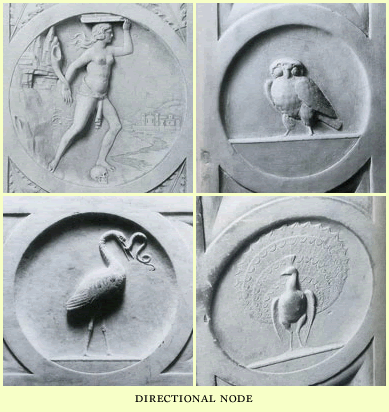
A door, I am going to speculate, is akin to a directional node in a Unicursal labyrinth. It does not necessarily mark a forking of the ways (although it might very well), but it does mark a passage from one state to the next. Hunter Sidney talks of the ornamental border separating cells of a single life; I wonder if he realises that he himself (as I suspect) provides the emblematic device on the hiddenmost interior of Mrs Isobel Easter’s domain.
back
...and the Massacre of the Innocents.
The original of the Massacre of the Innocents hangs in the Royal Collections at Hampton Court. A faithful copy, possibly a studio copy and perhaps even by Bruegel himself, hangs in the Kunsthistoriches Museum, Vienna. The latter testifies to substantial alterations made to the former at some later stage in its life, alterations made with the intention of ameliorating the grotesquery of the massacre. Dead children have become chickens, goats, parcels. It is a melancholy and Freudian translation, from the coherent and clear and tragic into the incoherent, the bizarre, the unreadable; but supportable.
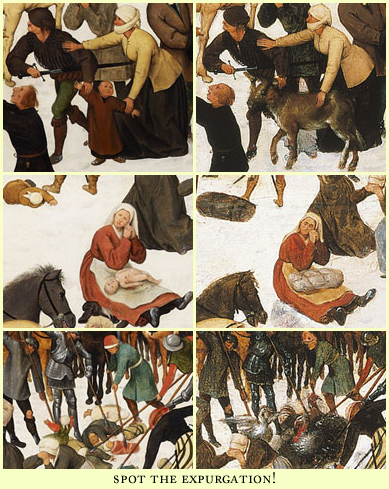
back
This, at any rate, is what Leonardo believed – that darkness or shadow is projected from certain dense and umbrous bodies, just as light is projected from certain 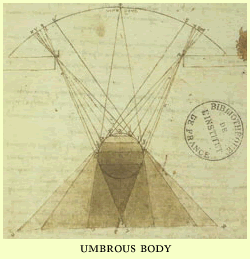 other, lighter bodies - the sun or the moon, candles, halos, and so on.
other, lighter bodies - the sun or the moon, candles, halos, and so on.
As Michael Baxandall notes in Shadows and Enlightment (1995), ‘Being dense is the opponent of being luminous. Leonardo, at this time, [between 1490 and 1493] is even prepared to say shadow is stronger than light because it can entirely extinguish it, whereas light cannot entirely extinguish the shadow caused by dense bodies.’ P. 152
It is doubtful whether Bruegel thought along these lines, but it is always worth remembering that dark, like cold, was a thing in the Renaissance, not an absence or a mere variant of light or heat.
back
...complex series of sortings...
Work on the doors had originally fallen on Giotto's recommendation to Andrea Pisano, who had produced one set (now on the south) beginning in around 1330. He had been under commission to produce a second set before financial crisis of the Bardi and Peruzzi banks and the  Black Death of 1348 intervened. His doors would remain in the privileged position on the east of the building facing the Cathedral until 1452, when they made way for Ghiberti’s second set. They now hang on the south side, gold on charcoal-grey like thermal-imaging of devotional or deific heat.
Black Death of 1348 intervened. His doors would remain in the privileged position on the east of the building facing the Cathedral until 1452, when they made way for Ghiberti’s second set. They now hang on the south side, gold on charcoal-grey like thermal-imaging of devotional or deific heat.
The competition to produce the second set arose in part from a rivalry between the Guild of the Calimala and that of the Lana (responsible for the Duomo itself) currently decorating the west facade of the Duomo directly opposite the Baptistery, but was also linked in Florentine minds with the deliverance of the city from Giangaleozzo Visconti of Milan in the summer of 1402.
The competition panels (Abraham’s hand stayed by the angel of God) and the first set of doors themselves, with their troubled stories of vengeance and punishment and mercy deferred, may not have been conceived as a votive offering, but they were certainly translated into that mode by history.
back

...contemptible under every point of rational regard.
But I quite like it.
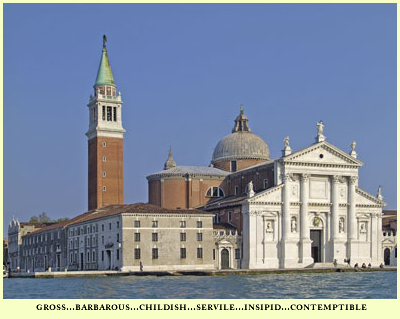
The Redentore, also, is a building of idiosyncratic beauty, with its double pedimented facade, and its interior of uninterrupted Corinthian, white marble and pietra serena. Both buildings are intently thought through and worked out, and pious in their way.
Which leads me to wonder, somewhat defensively, what Ruskin would have thought of Norbiton.
back


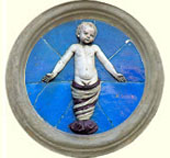

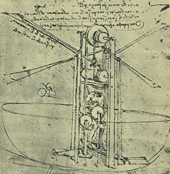


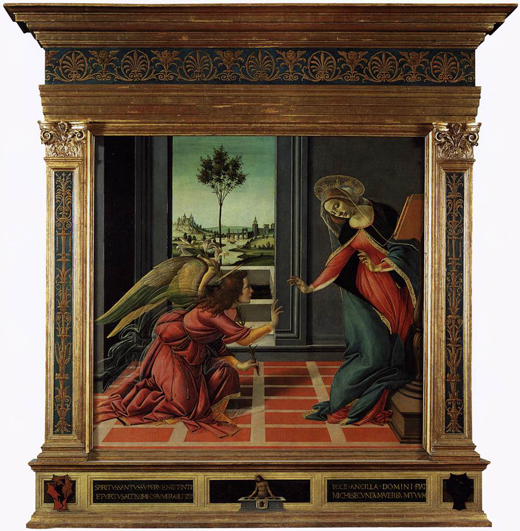


-500.png)
-500.png)

